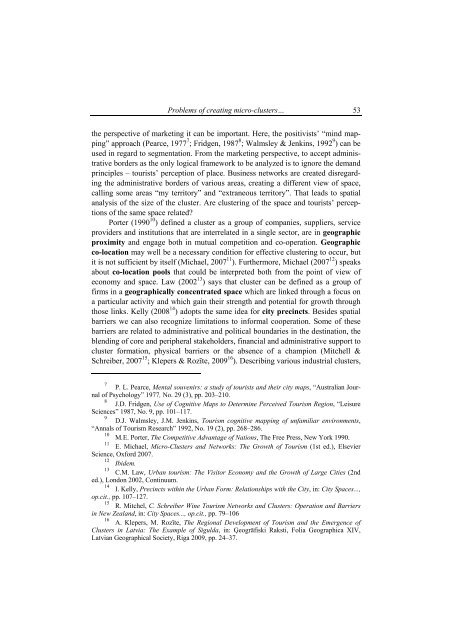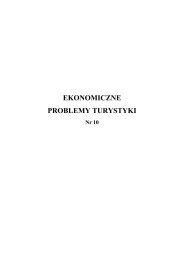Zeszyt naukowy - caÅoÅÄ - WydziaÅ ZarzÄ dzania i Ekonomiki UsÅug
Zeszyt naukowy - caÅoÅÄ - WydziaÅ ZarzÄ dzania i Ekonomiki UsÅug
Zeszyt naukowy - caÅoÅÄ - WydziaÅ ZarzÄ dzania i Ekonomiki UsÅug
Create successful ePaper yourself
Turn your PDF publications into a flip-book with our unique Google optimized e-Paper software.
Problems of creating micro-clusters… 53<br />
the perspective of marketing it can be important. Here, the positivists’ “mind mapping”<br />
approach (Pearce, 1977 7 ; Fridgen, 1987 8 ; Walmsley & Jenkins, 1992 9 ) can be<br />
used in regard to segmentation. From the marketing perspective, to accept administrative<br />
borders as the only logical framework to be analyzed is to ignore the demand<br />
principles – tourists’ perception of place. Business networks are created disregarding<br />
the administrative borders of various areas, creating a different view of space,<br />
calling some areas “my territory” and “extraneous territory”. That leads to spatial<br />
analysis of the size of the cluster. Are clustering of the space and tourists’ perceptions<br />
of the same space related?<br />
Porter (1990 10 ) defined a cluster as a group of companies, suppliers, service<br />
providers and institutions that are interrelated in a single sector, are in geographic<br />
proximity and engage both in mutual competition and co-operation. Geographic<br />
co-location may well be a necessary condition for effective clustering to occur, but<br />
it is not sufficient by itself (Michael, 2007 11 ). Furthermore, Michael (2007 12 ) speaks<br />
about co-location pools that could be interpreted both from the point of view of<br />
economy and space. Law (2002 13 ) says that cluster can be defined as a group of<br />
firms in a geographically concentrated space which are linked through a focus on<br />
a particular activity and which gain their strength and potential for growth through<br />
those links. Kelly (2008 14 ) adopts the same idea for city precincts. Besides spatial<br />
barriers we can also recognize limitations to informal cooperation. Some of these<br />
barriers are related to administrative and political boundaries in the destination, the<br />
blending of core and peripheral stakeholders, financial and administrative support to<br />
cluster formation, physical barriers or the absence of a champion (Mitchell &<br />
Schreiber, 2007 15 ; Klepers & Rozīte, 2009 16 ). Describing various industrial clusters,<br />
7<br />
P. L. Pearce, Mental souvenirs: a study of tourists and their city maps, “Australian Journal<br />
of Psychology” 1977, No. 29 (3), pp. 203–210.<br />
8<br />
J.D. Fridgen, Use of Cognitive Maps to Determine Perceived Tourism Region, “Leisure<br />
Sciences” 1987, No. 9, pp. 101–117.<br />
9<br />
D.J. Walmsley, J.M. Jenkins, Tourism cognitive mapping of unfamiliar environments,<br />
“Annals of Tourism Research” 1992, No. 19 (2), pp. 268–286.<br />
10<br />
M.E. Porter, The Competitive Advantage of Nations, The Free Press, New York 1990.<br />
11<br />
E. Michael, Micro-Clusters and Networks: The Growth of Tourism (1st ed.), Elsevier<br />
Science, Oxford 2007.<br />
12<br />
Ibidem.<br />
13<br />
C.M. Law, Urban tourism: The Visitor Economy and the Growth of Large Cities (2nd<br />
ed.), London 2002, Continuum.<br />
14<br />
I. Kelly, Precincts within the Urban Form: Relationships with the City, in: City Spaces...,<br />
op.cit., pp. 107–127.<br />
15<br />
R. Mitchel, C. Schreiber Wine Tourism Networks and Clusters: Operation and Barriers<br />
in New Zealand, in: City Spaces..., op.cit., pp. 79–106<br />
16<br />
A. Klepers, M. Rozīte, The Regional Development of Tourism and the Emergence of<br />
Clusters in Latvia: The Example of Sigulda, in: Ģeogrāfiski Raksti, Folia Geographica XIV,<br />
Latvian Geographical Society, Riga 2009, pp. 24–37.

















